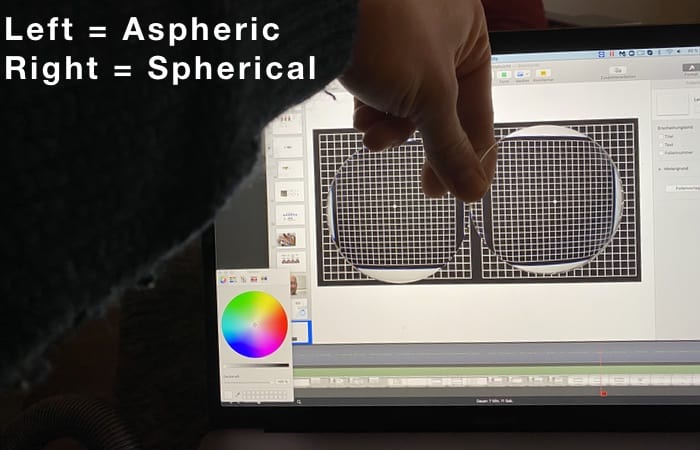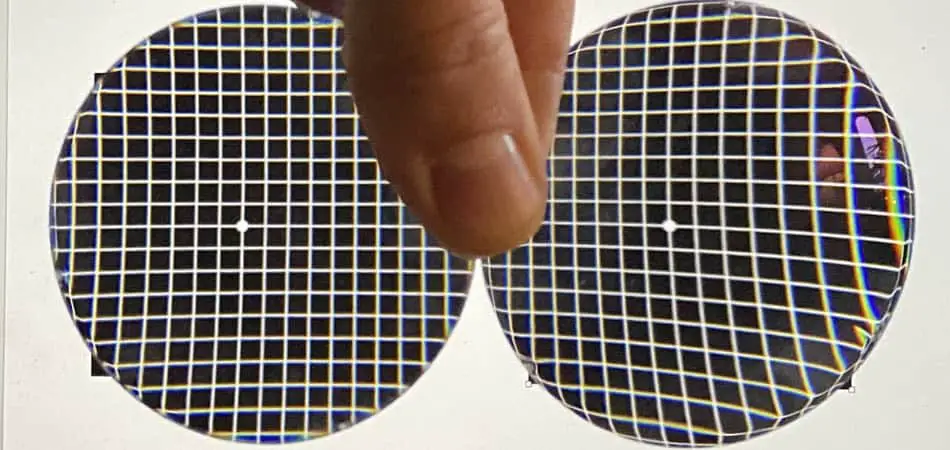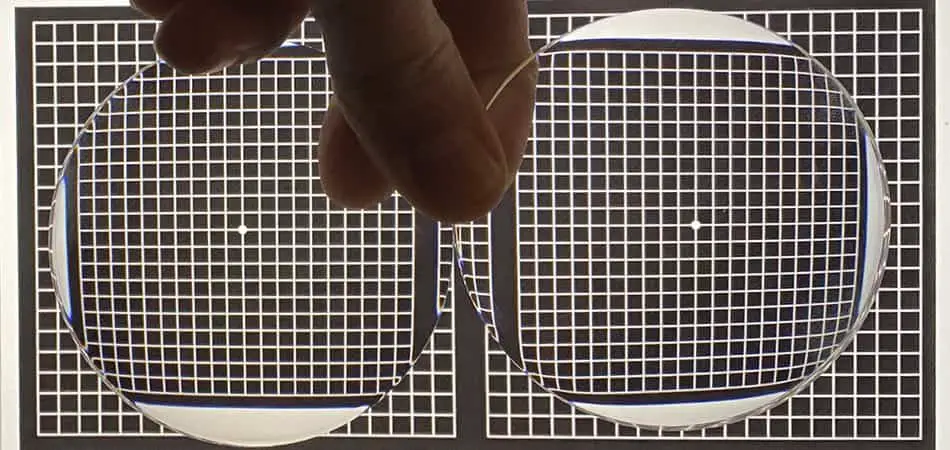Aspheric lenses are available in prescription glasses and readers, as well as contacts. They have changed the appearance of eyewear so that glasses are slimmer and lighter than ever. Glasses are now sleek and sophisticated, thanks to aspheric lenses.
Aspheric lenses feature a less convex profile than traditional corrective lenses, making aspheric lenses much more stylish. They are excellent for correcting various optical disorders, including astigmatism. The quality of corrected images is higher and peripheral vision is better with aspheric lenses compared to conventional lenses.
Aspheric lenses have a varying degree of curvature on their surface, which reduces the point of light reception. This has a profound effect on common optical aberrations. Let’s see how these lenses work.
Do You Need Aspheric Lenses?
Aspheric lenses may be just what the doctor ordered if you suffer from:
- Astigmatism
- Hypermetropia
- Myopia
These lenses correct common vision problems without creating the abnormal appearances caused by their spherical counterparts.
Low-Level Astigmatism Is Corrected By Aspheric Lenses
People who have astigmatism (who doesn’t?) may benefit from aspheric lenses. These lenses are excellent for correcting low to moderate astigmatism.
Whereas spherical lenses receive light at multiple points, creating a blur, aspheric lenses distill light down to one focal point, clearing things up.
Of course, these benefits vary with a range of factors, which include:
- Frames
- How the lenses are tilted in front of your eyes
- Distance from face
- Prescription-strength
- Level of astigmatism
Astigmatism thresholds vary for each person and what works well for one may not produce detectable results for another.
But many people notice an improvement in their astigmatism with aspherical lenses. This improvement can be noticed as a bigger clear field of view while performing eye movements or objects look less slanted with your glasses.
I wrote you an article here about why things might look slanted and how you could reduce this effect.
As soon as astigmatism is higher than two diopters atoric or free from lenses would be the better option.

Farsightedness Receives The Most Correction From Aspheric Lenses
Probably the greatest benefit from aspheric lenses comes to people who experience farsightedness.

Farsightedness results from an abnormally short eyeball which focuses light behind the retina instead of directly on it. This makes it difficult to focus on objects that are close to the viewer.
Spherical lenses made to correct hypermetropia are increasingly convex and thicker in the middle with a higher prescription. Depending on how high the farsightedness is, the lenses may be so thick that they produce a significant magnifying effect.
I wrote an article here for you on how the magnifying effect works and how to avoid it.
Aspheric Lenses Magnify the Eyes Less
Aspheric lenses have a flatter profile that reduces the unwanted magnification so that the eyes appear more normal in size.
This level of magnification in spherical lenses also sometimes distorts the view so that objects may appear bent or elongated.
Since aspherical lenses do not have such a pronounced convex surface, they correct this aberration to produce a clearer, more accurate representation of objects in the line of sight.
Depth Perception is Improved
Depth perception is skewed in conventional lenses because the intense magnification makes objects appear to be closer than they really are. Aspheric lenses correct this problem to represent distance in true perspective.
The ability to accurately perceive depth will help to prevent falls and the related embarrassment, not to mention sprained ankles.
Myopia Doesn’t Need To Be Intimidating With Aspheric Lenses
Nearsighted people usually experience less dramatic results with aspheric lenses, but the results are there.
Conventional correction lenses for nearsightedness are less convex than those for farsightedness, so there is not the problem of unwanted magnification.
In fact, the opposite problem occurs. Spherical minus prescription lenses are thicker at the edges than the center. This causes the wearer’s eyes to appear smaller.

If you want to know more about why your eyes look smaller and how to avoid it you can read this article here.
Since aspheric lenses are more optimized towards the edges of the lenses, this minimizing effect is slightly reduced.
Aspheric Lenses Outperform Spherical Lenses
When it comes to performance, aspheric lenses take home the blue ribbon. Compared to traditional spherical lenses, the aspheric lens is:
- Thinner
- Lighter
- Flatter
- Clearer
The lens itself is thinner, which opens up a whole new range of frame options. You can go with thin wireframes or no frame at all. But with all you read now, you start with the correct choice of the frame.

If the frame is to big from the beginning you will end up with lenses that are unnecessarily thick and heavier with the drawbacks mentioned above.
You should be very cautious with your choice if you need more than 4 diopters.
Due to the way these lenses are made, the optical experience is clearer with less distortion than spherical lenses.
The representation of objects is more natural.
Aspheric Lenses Do Have Disadvantages
Of course, aspheric lenses are also not the perfect solution. They do have some drawbacks. For the most part, however, these disadvantages are not enough to deter the consumer from purchasing them.
The major disadvantages of aspheric lenses are:
- Expense
- Limited field of view (still with higher astigmatism)
The corrective lenses industry has found ways to minimize these issues so that aspheric lenses are still preferable to conventional lenses.
Aspherical Lenses Are More Expensive
Aspheric lenses require much more work to produce than spherical lenses. It takes more time to produce these lenses because of the multiple steps involved.
Precision must be greater to get the proper result. All of this time and labor adds up to more dollars spent for aspheric lenses than for their spherical counterparts.
Aspheric lenses range from $100-$400 per lens. Any additional coatings, tints, or different materials can increase the price by $50-$150 more.
Throw in a pair of sturdy frames, and you could pay upwards of $1,000 for your specs.
If you don’t have vision insurance or if your insurance covers only a tiny portion of the cost, all this money has to come from your own pocket.
Considering that glasses need to be replaced approximately every four years, this can get rather expensive, especially if more than one person in the family wears glasses.
Not only do prescriptions change, but glasses get:
- Lost
- Broken
- Scratched
The need to pay out hundreds of dollars every time glasses need to be replaced might cause some people to think twice about going with aspheric lenses.
Most people, however, will pay the money because they know the quality is there.
If you don’t need to wear glasses all the time, you can save some money by purchasing a pair of reading glasses.
These usually come in strong corrective powers and some have aspheric lenses. These can help you if you only need extra help to read.
However, you should be evaluated by your optometrist to be sure this is the right decision for you. Wearing readers when you need prescription glasses will do more harm than good.
Aspherical Lenses also Have also A Reduced Visual Range
Because of the way the aspheric lens is made, it has an area that is clear for you to look through. This works against the natural way an eyeball moves.
So, when you attempt to give someone a side-eye through aspheric lenses, the effect may be spoiled by blurriness or a reduced field of vision.
Peripheral vision is somewhat limited by the shape of the lens. Of course, your frames may restrict this field even more.
In any case, you’ll likely find yourself needing to turn your head to view whatever is more than sixty degrees away from the center of your field of vision.
This can be a bit inconvenient especially when driving in heavy traffic. However, spherical lenses distort anything in the peripheral vision. However, this does not happen with contact lenses. So let us have a closer look at them. They can be aspheric too.
Aspheric Contact Lenses Leave Mixed Reviews
According to theory, aspheric contact lenses are supposed to bring light into a clearer, sharper focus, making the vision nearly perfect.
They are meant to correct natural spheric aberrations along with the aberrations created by the introduction of a contact lens onto the eye.
The problem is theory seldom works the way it’s supposed to. For the most part, aspheric contact lenses seem to be hardly any better than spherical contact lenses.
The single focal point that gathers light as it enters the eye produces a better image than spherical lenses that allow light to scatter.
Of course, the higher prescription is the more you could notice a difference. Especially for wearers of contacts with a prescription under four diopters, there will be hardly any difference compared to a spherical contact lens.
Although the aspheric design changes the way the light falls into your eyes it will not interfere with other distances like while reading as this study shows. So, in my opinion as an optician, it is worthwhile to give the aspheric lenses a chance.
Clinical Trials Show High Performance with Contact Lenses (Multifocal Contacts)
In clinical trials, the aspheric contact lenses made by Cooper Vision (Biomedics Premier) showed high levels of performance in correcting both natural spheric aberrations and aberrations caused by the power of the contact itself.
Aspheric contact lenses are available in bifocal and multi-focal applications. Bifocals usually adjust for distance and reading vision. You essentially have two prescriptions in one lens.
Multi-focals correct for:
- Farsightedness
- Astigmatism
- Intermediate vision
- Nearsightedness
These are multiple prescriptions in one lens. It may take a while for your eyes to adjust and your brain to learn how to effectively use all three levels of corrected vision.
However in most cases those lenses will reduce contrast slightly and could give you more glare while driving at night. So in some case they just will not be the solution for you if you expect brilliant vision.
Who Shouldn’t Wear Aspheric Lenses?
Aspherical lenses are not for everyone. Some people may actually notice their vision worsen with aspheric lenses, especially with multifocal contact lenses.
Those who have higher astigmatism usually will have a bigger clear field of view with atoric lenses.
People who have a prescription lower than four diopters will hardly see any improvement with aspheric lenses. This type of contact lens is for those who need a higher prescription.
If mild correction only is needed, aspheric contact lenses are probably not for you. Because no effect will be seen.
Whether or not you can use aspherical lenses depends on a range of factors, including the shape of your eyes.
Be sure to ask your optometrist whether aspheric lenses are right for you.
Aspheric Lens Implants Are Used After Cataract Surgery
As age advances, so do cataracts. The only solution for cataracts is surgery, which involves removing the natural lens of the eye and replacing it with an intraocular lens.
Since this lens is responsible for focusing light rays, it must be replaced. They oftentimes get replaced with an aspheric intraocular (IOL) lens that is implanted, usually behind the iris.
You will benefit more from an aspheric intraocular lens when your pupils are bigger. In a lot of cases people with smaller pupils let us say 3mm will not get the theoretical benefits of an aspheric lens. However if your pupils are bigger aspherics will be effective in producing clearer image.
For more information on aspheric vs spheric IOLs you can read this study here.
Aspheric Lenses Are Multifunctional
Eyeglasses aren’t the only place that aspheric lenses are found. Aspheric lenses are also used in digital cameras to correct the problem of “soft edges.”
Using a spherical lens will cause spheric aberrations, which manifest as soft edges on an image. Soft edges mean that the perimeters of the picture seem a little washed out.
The colors aren’t as vibrant as they are in the center of the picture, and there may even be some distortion or “fish-eye” effect.
You won’t notice so much if you’re using a wide-angle lens, but when the picture needs to be sharp and focused, you’ll see the wash-out at the edges of the image.
All these problems can be corrected using an aspheric lens.
The aspheric lens focuses light at one point instead of allowing it to create multiple focal points as a spherical lens does.
This gathering of light to one point makes the image sharper and clearer from edge to edge.
To get a picture of this quality from a spherical lens, it would require multiple lenses, which would reduce the lighting and misrepresent the colors.
One aspheric lens can often replace several spherical lenses by focusing the light in one place.
Like glasses, aspheric camera lenses are more expensive than spherical lenses, but they are well worth their price for the high-quality images they produce.
So, Do You Need Aspheric Lenses?
Many people benefit from aspheric lenses. Should you be one of them? Only your optometrist or optician can answer that, but it is worth asking her about it if you experience:
- Mild to moderate astigmatism
- Farsightedness
- Nearsightedness
Should you wear glasses or contacts? That probably depends on how much correction your vision needs and whether you need correction for distance or for close-up work.
Whatever your doctor recommends, be sure to do your own research, so you get the best corrective lenses to suit your needs.
